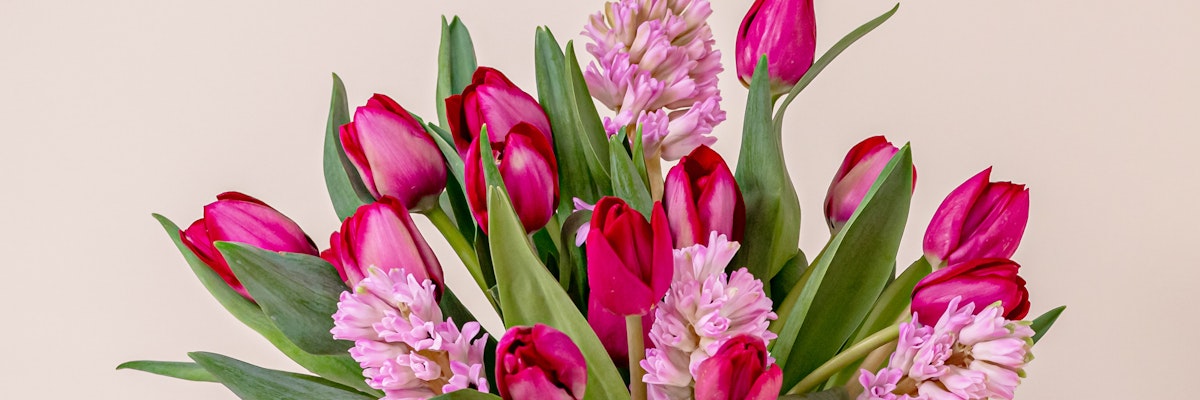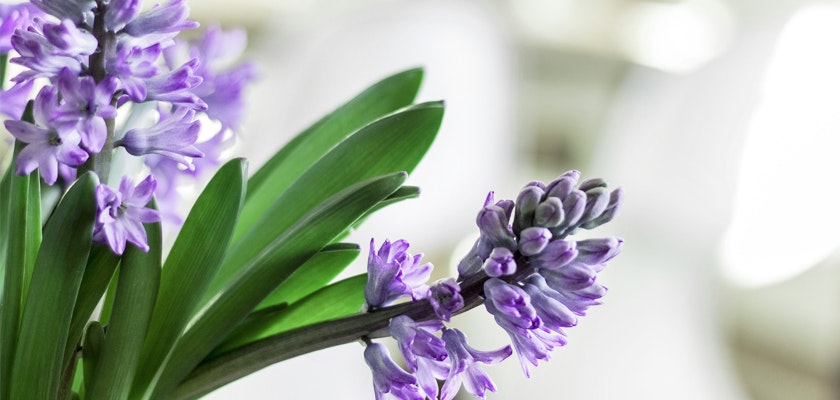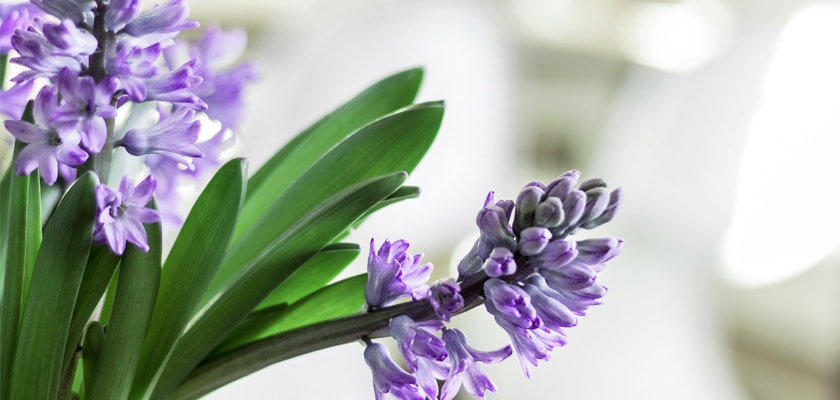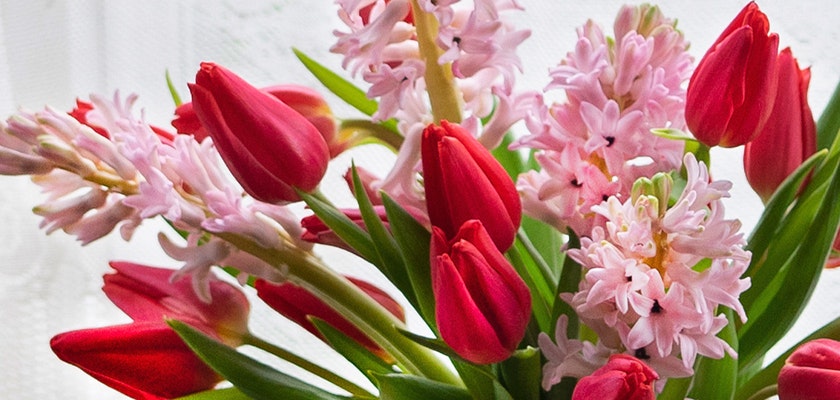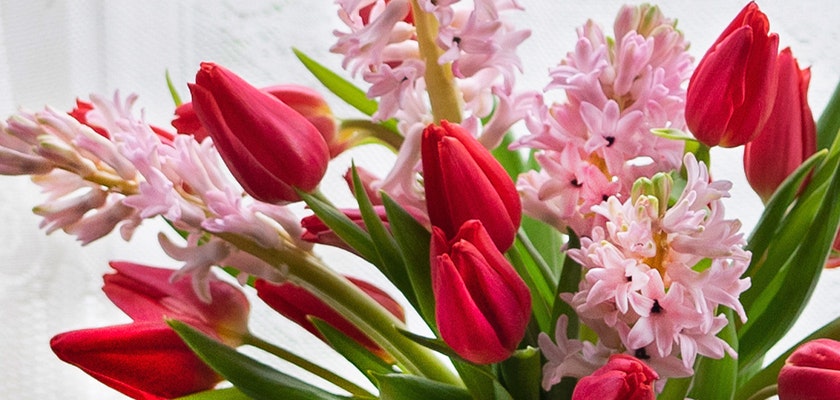Unfolding the Hyacinth: Origin, Symbolism, and Significance
Flowers have a unique way of communicating sentiments that words often fail to express. Among these, the hyacinth holds a special place with its vibrant colors and intoxicating fragrance.
Dive into the captivating world of hyacinths and explore their history, symbolism and color meanings
This bulbous plant, blooming in the early spring, carries a deep well of symbolism and historical significance.
The hyacinth's name comes from an ancient tale of love and sorrow, and each color of its blossoms conveys a different sentiment. Whether it's the playful joy symbolized by pink hyacinths or deep regret represented by purple ones, this flower has been used for centuries to communicate emotions.
Dive into the captivating world of hyacinths and explore their history, symbolism and color meanings
This bulbous plant, blooming in the early spring, carries a deep well of symbolism and historical significance.
The hyacinth's name comes from an ancient tale of love and sorrow, and each color of its blossoms conveys a different sentiment. Whether it's the playful joy symbolized by pink hyacinths or deep regret represented by purple ones, this flower has been used for centuries to communicate emotions.
Delving into the origin, mythology, and symbolism of the hyacinth not only gives us a deeper understanding of this beautiful flower but also helps us appreciate the silent language it speaks. By unraveling the meanings hidden in its hues, we can use the hyacinth to convey our feelings more effectively.
Whether you're a florist, a gardener, or someone who simply appreciates the beauty and symbolism of flowers, this comprehensive guide to the hyacinth will provide you with intriguing insights. So, let's embark on this floral journey and explore the fascinating world of the hyacinth.
Hyacinth Origin and History
The hyacinth is believed to have originated in the eastern Mediterranean region, particularly in modern-day Turkey and Lebanon. Its scientific name, Hyacinthus, can be traced back to Greek mythology, which we'll delve into in the next section. The flower then spread across Europe, where it was cultivated extensively in the Netherlands.
The hyacinth's intoxicating scent and vibrant colors made it a favorite among European nobility during the 17th and 18th centuries. It was during this period that many of the hyacinth varieties we know today were developed. The flower's popularity peaked in the early 18th century, a period often referred to as 'Hyacinth Mania'.
Despite its Mediterranean origins, the hyacinth is a hardy flower that can withstand colder climates, which partly explains its widespread cultivation and popularity in Europe. Over time, its cultivation spread across the globe, and today the hyacinth is a common sight in gardens and bouquets worldwide.
The Hyacinth in Greek Mythology
In Greek mythology, the origin of the hyacinth is tied to a tale of love and tragedy involving Apollo, the god of the sun, and a handsome youth named Hyacinthus. As the story goes, Apollo and Hyacinthus were close companions, but their relationship ended in tragedy when a discus thrown by Apollo was blown off course by the jealous wind god Zephyrus, striking and killing Hyacinthus.
Devastated by his friend's death, Apollo refused to let Hades, the god of the underworld, claim Hyacinthus. Instead, he transformed his fallen friend into a flower— a hyacinth, marking the earth with his beauty. It's said that Apollo's tears fell on the petals of the hyacinth, forming patterns of 'AI AI', the Greek expression of grief.
This tragic tale of love and loss gave the hyacinth its name and its initial symbolic associations with sorrow and rebirth. It's a reminder of how deeply flowers are intertwined with human emotions and stories, carrying messages far beyond their visual beauty.
Hyacinth Symbolism
The hyacinth is rich in symbolism, much of it derived from its mythological origins. Due to its association with Apollo, the flower is sometimes linked to the themes of power, pride, and beauty. However, the story of Hyacinthus' tragic death also lends the hyacinth connotations of sorrow and mourning.
Interestingly, the hyacinth also symbolizes playfulness and sport, likely due to Apollo's association with physical prowess and the circumstances of Hyacinthus' death. It's a reminder of how complex and multifaceted flower symbolism can be, with one flower carrying a host of seemingly contrasting meanings.
In some cultures, the hyacinth is associated with rebirth and renewal, likely due to its spring blooming and its mythological transformation from a youth to a flower. This makes it a fitting symbol for the Persian New Year, Nowruz, where it's used in the traditional Haftseen table setting.
Delving into the origin, mythology, and symbolism of the hyacinth not only gives us a deeper understanding of this beautiful flower but also helps us appreciate the silent language it speaks. By unraveling the meanings hidden in its hues, we can use the hyacinth to convey our feelings more effectively.
Whether you're a florist, a gardener, or someone who simply appreciates the beauty and symbolism of flowers, this comprehensive guide to the hyacinth will provide you with intriguing insights. So, let's embark on this floral journey and explore the fascinating world of the hyacinth.
Hyacinth Origin and History
The hyacinth is believed to have originated in the eastern Mediterranean region, particularly in modern-day Turkey and Lebanon. Its scientific name, Hyacinthus, can be traced back to Greek mythology, which we'll delve into in the next section. The flower then spread across Europe, where it was cultivated extensively in the Netherlands.
The hyacinth's intoxicating scent and vibrant colors made it a favorite among European nobility during the 17th and 18th centuries. It was during this period that many of the hyacinth varieties we know today were developed. The flower's popularity peaked in the early 18th century, a period often referred to as 'Hyacinth Mania'.
Despite its Mediterranean origins, the hyacinth is a hardy flower that can withstand colder climates, which partly explains its widespread cultivation and popularity in Europe. Over time, its cultivation spread across the globe, and today the hyacinth is a common sight in gardens and bouquets worldwide.
The Hyacinth in Greek Mythology
In Greek mythology, the origin of the hyacinth is tied to a tale of love and tragedy involving Apollo, the god of the sun, and a handsome youth named Hyacinthus. As the story goes, Apollo and Hyacinthus were close companions, but their relationship ended in tragedy when a discus thrown by Apollo was blown off course by the jealous wind god Zephyrus, striking and killing Hyacinthus.
Devastated by his friend's death, Apollo refused to let Hades, the god of the underworld, claim Hyacinthus. Instead, he transformed his fallen friend into a flower— a hyacinth, marking the earth with his beauty. It's said that Apollo's tears fell on the petals of the hyacinth, forming patterns of 'AI AI', the Greek expression of grief.
This tragic tale of love and loss gave the hyacinth its name and its initial symbolic associations with sorrow and rebirth. It's a reminder of how deeply flowers are intertwined with human emotions and stories, carrying messages far beyond their visual beauty.
Hyacinth Symbolism
The hyacinth is rich in symbolism, much of it derived from its mythological origins. Due to its association with Apollo, the flower is sometimes linked to the themes of power, pride, and beauty. However, the story of Hyacinthus' tragic death also lends the hyacinth connotations of sorrow and mourning.
Interestingly, the hyacinth also symbolizes playfulness and sport, likely due to Apollo's association with physical prowess and the circumstances of Hyacinthus' death. It's a reminder of how complex and multifaceted flower symbolism can be, with one flower carrying a host of seemingly contrasting meanings.
In some cultures, the hyacinth is associated with rebirth and renewal, likely due to its spring blooming and its mythological transformation from a youth to a flower. This makes it a fitting symbol for the Persian New Year, Nowruz, where it's used in the traditional Haftseen table setting.
Hyacinth Meaning by Color
One of the unique aspects of the hyacinth is the different meanings conveyed by its various colors.
Purple Hyacinths: Purple hyacinths carry a message of deep regret and sorrow, asking for forgiveness. They're often given as a sign of longing or to express a sense of sorry. In this context, they serve as a poignant reminder of the tragic tale of Apollo and Hyacinthus.
Yellow Hyacinths: Yellow hyacinths have a more cautionary symbolism, representing jealousy. While they're as beautiful and fragrant as other hyacinths, their color gives them a unique message. They serve as a reminder of Zephyrus' jealous act that led to Hyacinthus' death.
Pink Hyacinths: On a lighter note, pink hyacinths symbolize 'playful joy'. They might be used to lighten the mood or to bring a sense of fun and playfulness. Despite the tragic story associated with hyacinths, these pink blooms remind us of the flower's association with sport and play.
Blue Hyacinths: Blue hyacinths convey sincerity. They're often given to express genuine, heartfelt emotions. Their calming color combined with their rich fragrance makes them a popular choice in many floral arrangements.
White Hyacinths: White hyacinths symbolize purity and loveliness. They might also represent prayers for the recipient or symbolize a love that's less passionate and more about stable, enduring affection.
Hyacinth Fun Facts
A Fragrant History: The hyacinth is known for its heady, intoxicating scent. In fact, in the 17th and 18th centuries, the flower was so popular and widely grown in Holland for its fragrance that it led to a period known as 'Hyacinth Mania', similar to the famous Dutch 'Tulip Mania'.
A Rainbow of Colors: Hyacinths come in a variety of colors, including blue, purple, pink, red, orange, yellow, and white. Each color carries its own unique symbolism, making the hyacinth a versatile flower for expressing a range of sentiments.
The Hyacinth Bean: Despite its name, the hyacinth bean is not a true hyacinth. It's a climbing vine with purple flowers and shiny, magenta pods. While not directly related, both plants share a certain robust beauty.
An Edible Flower?: While the bulbs of the hyacinth plant are poisonous if ingested, in some cultures, certain parts of the plant are used in cooking. However, extreme caution should be taken, and it's generally advised to keep hyacinths out of the kitchen.
A Part of Persian New Year: The hyacinth plays a significant role in the celebration of Nowruz, the Persian New Year. It's one of the seven symbolic items (Haft Seen) displayed during the festivities, representing the coming of spring and rebirth.
A Robust Bloom: Hyacinths are hardy flowers that can grow in a variety of climates, from Mediterranean regions to colder European climates. This adaptability has contributed to their widespread popularity and cultivation.
A Popular Name: The name 'Hyacinth' is used not only for the flower but also as a personal name in various cultures. It's particularly popular in Greek culture due to its mythological origins.
A Springtime Bloom: Hyacinths are one of the earliest flowers to bloom in spring, often poking through the last remnants of snow. This makes them a symbol of rebirth and renewal.
A Family Connection: Hyacinths belong to the Asparagaceae family, making them relatives of asparagus. Despite their very different appearances, they share certain botanical characteristics.
A Symbol of Sport: Interestingly, the hyacinth is associated with sport and play in the language of flowers. This connection likely stems from the Greek myth of Apollo and Hyacinthus, where a game of discus led to Hyacinthus' tragic death.
Hyacinth Meaning by Color
One of the unique aspects of the hyacinth is the different meanings conveyed by its various colors.
Purple Hyacinths: Purple hyacinths carry a message of deep regret and sorrow, asking for forgiveness. They're often given as a sign of longing or to express a sense of sorry. In this context, they serve as a poignant reminder of the tragic tale of Apollo and Hyacinthus.
Yellow Hyacinths: Yellow hyacinths have a more cautionary symbolism, representing jealousy. While they're as beautiful and fragrant as other hyacinths, their color gives them a unique message. They serve as a reminder of Zephyrus' jealous act that led to Hyacinthus' death.
Pink Hyacinths: On a lighter note, pink hyacinths symbolize 'playful joy'. They might be used to lighten the mood or to bring a sense of fun and playfulness. Despite the tragic story associated with hyacinths, these pink blooms remind us of the flower's association with sport and play.
Blue Hyacinths: Blue hyacinths convey sincerity. They're often given to express genuine, heartfelt emotions. Their calming color combined with their rich fragrance makes them a popular choice in many floral arrangements.
White Hyacinths: White hyacinths symbolize purity and loveliness. They might also represent prayers for the recipient or symbolize a love that's less passionate and more about stable, enduring affection.
Hyacinth Fun Facts
A Fragrant History: The hyacinth is known for its heady, intoxicating scent. In fact, in the 17th and 18th centuries, the flower was so popular and widely grown in Holland for its fragrance that it led to a period known as 'Hyacinth Mania', similar to the famous Dutch 'Tulip Mania'.
A Rainbow of Colors: Hyacinths come in a variety of colors, including blue, purple, pink, red, orange, yellow, and white. Each color carries its own unique symbolism, making the hyacinth a versatile flower for expressing a range of sentiments.
The Hyacinth Bean: Despite its name, the hyacinth bean is not a true hyacinth. It's a climbing vine with purple flowers and shiny, magenta pods. While not directly related, both plants share a certain robust beauty.
An Edible Flower?: While the bulbs of the hyacinth plant are poisonous if ingested, in some cultures, certain parts of the plant are used in cooking. However, extreme caution should be taken, and it's generally advised to keep hyacinths out of the kitchen.
A Part of Persian New Year: The hyacinth plays a significant role in the celebration of Nowruz, the Persian New Year. It's one of the seven symbolic items (Haft Seen) displayed during the festivities, representing the coming of spring and rebirth.
A Robust Bloom: Hyacinths are hardy flowers that can grow in a variety of climates, from Mediterranean regions to colder European climates. This adaptability has contributed to their widespread popularity and cultivation.
A Popular Name: The name 'Hyacinth' is used not only for the flower but also as a personal name in various cultures. It's particularly popular in Greek culture due to its mythological origins.
A Springtime Bloom: Hyacinths are one of the earliest flowers to bloom in spring, often poking through the last remnants of snow. This makes them a symbol of rebirth and renewal.
A Family Connection: Hyacinths belong to the Asparagaceae family, making them relatives of asparagus. Despite their very different appearances, they share certain botanical characteristics.
A Symbol of Sport: Interestingly, the hyacinth is associated with sport and play in the language of flowers. This connection likely stems from the Greek myth of Apollo and Hyacinthus, where a game of discus led to Hyacinthus' tragic death.
BloomsyBox's Bouquets
When it comes to expressing sentiments through flowers, BloomsyBox offers a range of beautifully arranged bouquets that include the meaningful hyacinth. Their selection spans various colors of hyacinths, allowing you to choose an arrangement that best expresses your sentiments.
BloomsyBox's bouquets are handpicked and arranged by expert florists, ensuring each bouquet is of the highest quality. They are then shipped directly from sustainable farms, guaranteeing fresh, vibrant blooms.
One of the benefits of choosing BloomsyBox is the ease and convenience of their delivery service. You can send a bouquet directly to a loved one's home, or wherever it's needed most, with just a few clicks.
Furthermore, each BloomsyBox bouquet is more than just a collection of beautiful flowers. It's a carefully crafted message of love, support, and respect, offering comfort during a difficult time.
BloomsyBox's Bouquets
When it comes to expressing sentiments through flowers, BloomsyBox offers a range of beautifully arranged bouquets that include the meaningful hyacinth. Their selection spans various colors of hyacinths, allowing you to choose an arrangement that best expresses your sentiments.
BloomsyBox's bouquets are handpicked and arranged by expert florists, ensuring each bouquet is of the highest quality. They are then shipped directly from sustainable farms, guaranteeing fresh, vibrant blooms.
One of the benefits of choosing BloomsyBox is the ease and convenience of their delivery service. You can send a bouquet directly to a loved one's home, or wherever it's needed most, with just a few clicks.
Furthermore, each BloomsyBox bouquet is more than just a collection of beautiful flowers. It's a carefully crafted message of love, support, and respect, offering comfort during a difficult time.
In conclusion, while the hyacinth is a beautiful flower to behold, understanding its rich history and symbolism adds depth to its beauty. Whether you're sending a bouquet to express regret with purple hyacinths or playful joy with pink ones, this guide can help you articulate your sentiments more effectively. And with services like BloomsyBox, expressing these sentiments is just a few clicks away.
In conclusion, while the hyacinth is a beautiful flower to behold, understanding its rich history and symbolism adds depth to its beauty. Whether you're sending a bouquet to express regret with purple hyacinths or playful joy with pink ones, this guide can help you articulate your sentiments more effectively. And with services like BloomsyBox, expressing these sentiments is just a few clicks away.
